
RUSH Alex lifeson first video
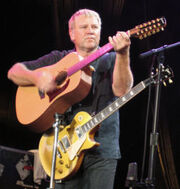
Alex Lifeson performing "The Trees" live in concert with RUSH in 2008.
OC Alex "Lerxst" Lifeson, (Born Aleksandar Živojinović on August 27, 1953) is the guitarist for the Canadian rock band Rush. Lifeson founded Rush in the summer of 1968. He plays guitar, mandola, mandolin, and bouzoki, and has also been known to play Moog Taurus pedals as well as sing back up vocals when performing live. Along with the other two members of RUSH, he was made an Officer of the Order of Canada, the highest civilian award available.
Biography[]
The Early Years[]
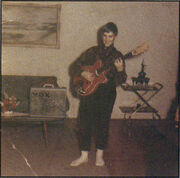
A Young Lifeson Playing his Canora Guitar in the living room of the family home in Toronto.
Born in Fernie, British Columbia to Serbian immigrants, Lifeson grew up in Toronto, Ontario. After a failed attempt at learning to play the Viola, Lifeson received his first guitar.
The Projection, RUSH, and Hadrian[]
'See History Of Rush
Influenced by the likes of Eric Clapton, Jeff Beck, and Jimi Hendrix, Lifeson formed The Projection with friend John Rutsey on drums in 1967/68. Rutsey and Lifeson were joined briefly by bassist/ vocalist Jeff Jones in June 1968 to form Rush. On the evening before a gig in August 1968, Jones called in unable to make it, and in need of a vocalist and bassist for a gig, Lifeson called friend and classmate Geddy Lee and invited him into the band.
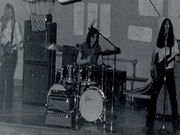
Lifeson, Rutsey, and Lee playing in the earliest incarnation of RUSH.
Accepting the offer, Lee , Lifeson and Rutsey played at the Coff-In, a local teenage hangout in the basement of an Anglican Church, covering Cream songs for $10. After the gig, they split the money and went out for dinner. Jones quit because of other commitments, and Lee was made a permanent member that evening. Lifeson, Lee and Rutsey continued to play the Coff-In, steadily developing a group of followers.
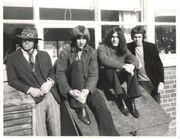
Hadrian.
After brief stints with other bands, and a temporary disbandment for RUSH, Lifeson, Lee and Rutsey decided to reform RUSH. Resuming their weekly circuit of local Churches, High School Dances, and drop in centres, Lifeson and the reformed RUSH began to draw impressive crowds playing their cover tunes. With Lifeson and Lee still in school, things began to really get crazy. Eventually, Lee would drop out, leaving Lifeson as the only member of RUSH to graduate.
The turn of the decade only brought more changes, when the provincial drinking age was dropped from 21 to 18, opening up the bar circuit and hundreds of new gig opportunities, and Lifeson moved out of his parents and in with his girlfriend, Charlene, at age 17. Charlene gave birth to their son, Justin, soon after. In need of ways to support themselves, the band members were forced to take up jobs on the side, Lifeson working as a Plumber's mate with his father. It was also sometime in 1970/71 that Lifeson was a part of the documentary Come On Children, aired in 1972, it was a film in which a group of troubled teens were left to live on a farm house, similar to reality shows today. The documentary never picked up much interest, but it contains the earliest known footage of Lifeson playing guitar, a clip in which he plays a RUSH composition called "Run Willie Run." for the other kids. Lifeson began taking classical guitar lessons from classmate Eliot Goldner, but they were brought to an untimely end when Goldner was landed in the hospital from a motorcycle crash. After a slow summer with only three gigs, RUSH was able to book a place to record in the Fall of 1972, St Rochdale College. The tapes of these recording sessions were later lost. In the fall of 1973, RUSH again went into the studio, this time to record their first single. The record was turned down by every label in Canada twice. Taken from the biography Contents Under Pressure:
Lifeson, Rutsey, and Lee At the time of the recording of RUSH.
Towards the end of 1973, Rush played their biggest gig so far, opening up for the New York Dolls at a Toronto concert hall. Having garnered a strong following on the local club circuit, the group had little difficulty in blowing the headliners off stage. Yet, despite their ever-increasing popularity and the fact that they had earned enough money to make an album, Rush faced one major problem -- a total lack of record company interest.
"It was extremely hard for us to get a deal," reflects Alex. "Nobody wanted to sign us because we just weren't considered 'sellable' at the time. In Canada, if you were the Guess Who, then you had a much better chance because you had something that was very commercial, which could be heard on the radio. We always had a strange reputation in the Canadian music industry. Nobody wanted to know us because we were labeled as being too heavy, with a singer who had a crazy voice."
Consequently, Rush was forced to enter the studios without the support of a record label. The band was aided by longtime manager Ray Danniels and his partner Vic Wilson. Danniels had initially become involved with the trio after promoting a South Ontario high school concert several years earlier. However, allocating recording time was extremely difficult, since the group had to keep gigging in order to sustain their cash-flow.
"We had to start work after playing in a club and record through the night," Alex explains. "We'd tear down the gear and go in at two in the morning until eight, when we had to get out. You'd do that one week, but then you couldn't get back in the studios for another three weeks, which was very frustrating. But we had no other options. Without a proper record company behind us, we had to make do the best we could." Finally, in early 1974, their self-titled debut LP was released on Moon Records, an independent label started by Danniels , Wilson and RUSH.
The cover featured the band's name printed in red (later reprinted as pink by Anthem Records) exploding from a backdrop of white.
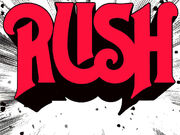
Rush's Debut Album (1974)